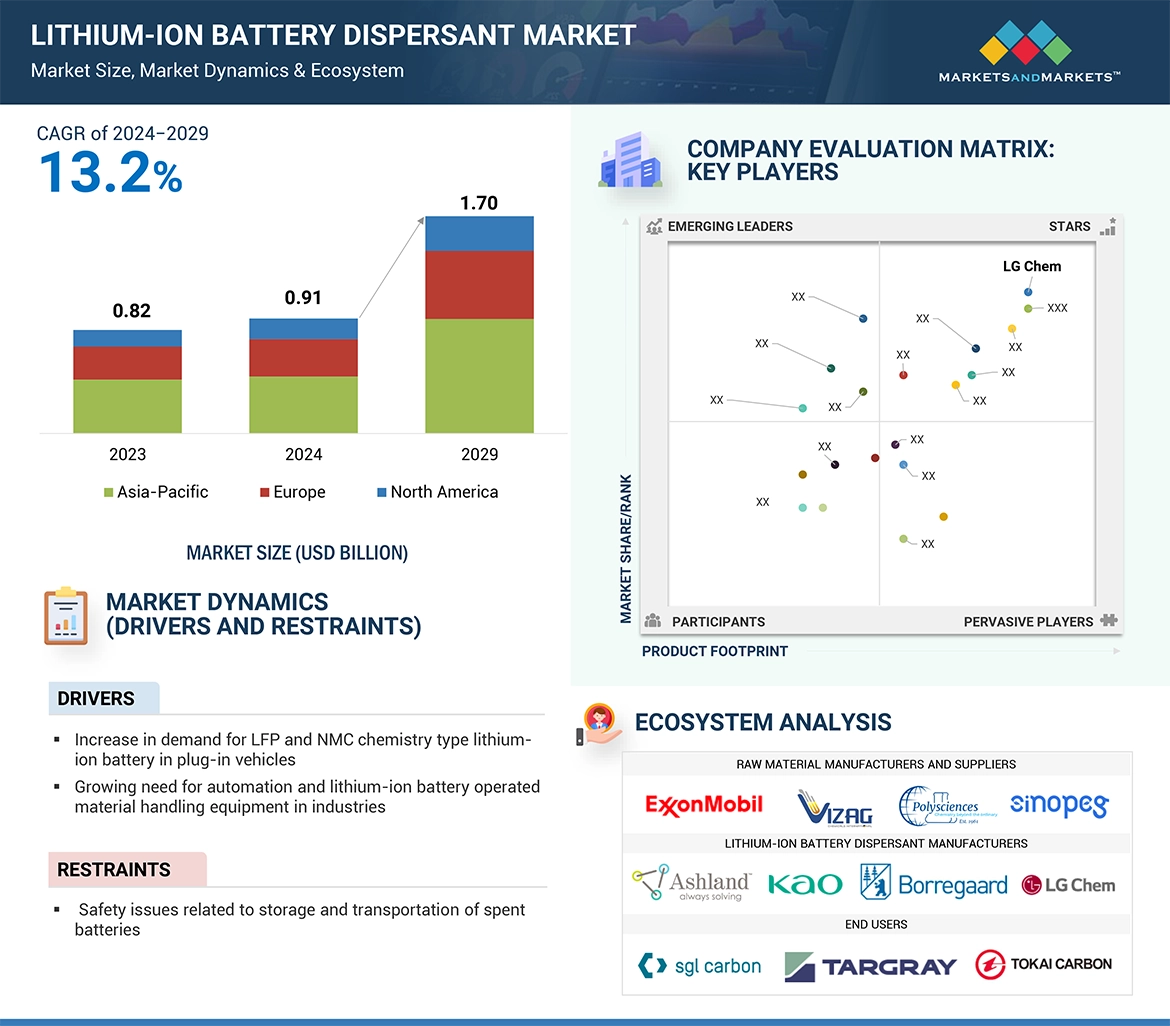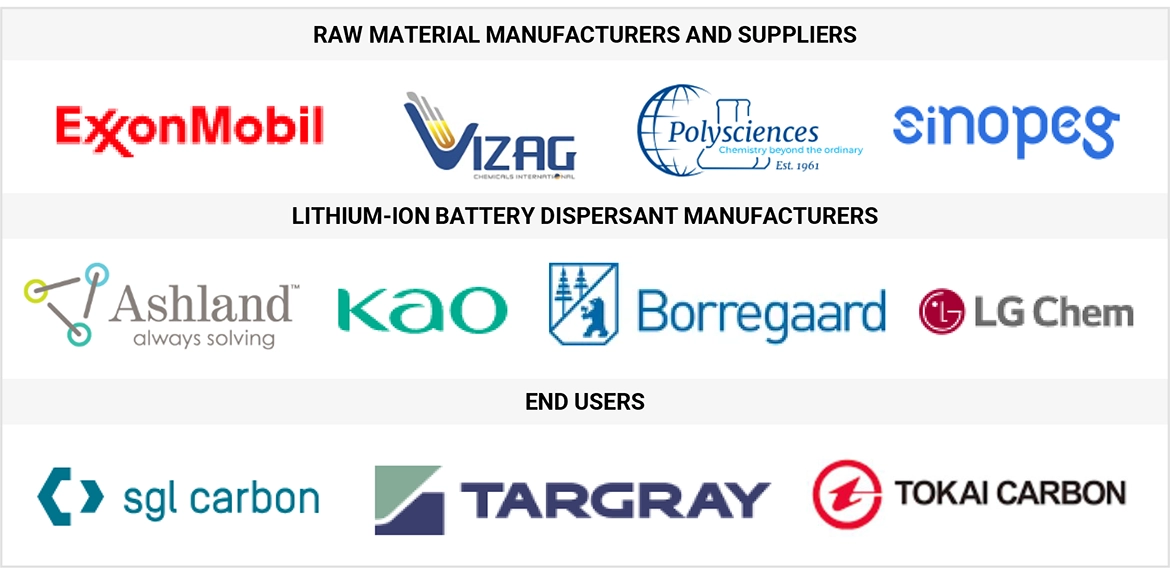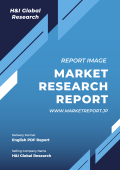
1 はじめに 19
1.1 調査目的 19
1.2 市場の定義 19
1.3 調査範囲 20
1.3.1 対象市場と地域範囲 20
1.3.2 対象範囲と除外範囲 20
1.3.3 考慮した年数 21
1.3.4 考慮した通貨 21
1.4 制限事項 21
1.5 利害関係者 22
1.6 変更点のまとめ 22
2 調査方法 23
2.1 調査データ 23
2.1.1 二次データ 24
2.1.1.1 二次資料からの主要データ 24
2.1.2 一次データ 24
2.1.2.1 一次資料からの主要データ 25
2.1.2.2 専門家へのインタビューの内訳 25
2.2 需要サイドマトリックス 26
2.3 市場規模の推定 26
2.3.1 ボトムアップアプローチ 27
2.3.2 トップダウンアプローチ 27
2.3.2.1 供給側分析のための計算 28
2.4 成長予測 29
2.5 データ三角測量 29
2.5.1 調査の前提 30
2.5.2 調査の限界 30
2.5.3 リスク評価 30
3 エグゼクティブ・サマリー 31
4 プレミアムインサイト 34
4.1 リチウムイオン電池用分散剤市場における魅力的な機会 34
4.2 リチウムイオン電池用分散剤市場、地域別 34
4.3 リチウムイオン電池用分散剤市場:主要国別 35
5 市場の概要 36
5.1 はじめに 36
5.2 市場ダイナミクス 36
5.2.1 推進要因 37
5.2.1.1 プラグイン自動車におけるLFPおよびNMC化学タイプのリチウムイオン電池の需要増 37
5.2.1.2 産業界における自動化とリチウムイオン電池作動の運搬機器へのニーズの高まり 37
5.2.1.3 リチウムイオン電池を使用するスマートデバイスやその他の工業製品の開発 37
5.2.1.4 再生可能エネルギー貯蔵における採用の増加 38
5.2.2 阻害要因 38
5.2.2.1 使用済み電池の保管・輸送に関する安全性の問題 38
5.2.3 機会 38
5.2.3.1 リチウムイオン電池の価格低下 38
5.2.3.2 メーカーによるリチウムイオン電池改良のための研究開発イニシアチブの増加 39
5.2.4 課題 40
5.2.4.1 リチウムイオン電池の過熱 40
6 業界動向 41
6.1 世界のマクロ経済見通し 41
6.1.1 GDP 41
6.1.2 電気自動車の普及拡大 43
6.2 バリューチェーン分析 44
6.3 エコシステム分析 45
6.4 ポーターの5つの力分析 46
6.4.1 サプライヤーの交渉力 47
6.4.2 買い手の交渉力 47
6.4.3 新規参入者の脅威 47
6.4.4 代替品の脅威 47
6.4.5 競合の激しさ 48
6.5 主要ステークホルダーと購買基準 48
6.5.1 購入プロセスにおける主要ステークホルダー 48
6.5.2 購入基準 49
6.6 価格分析 49
6.6.1 リチウムイオン電池用分散剤の平均販売価格(分散剤タイプ別) 50
分散剤タイプ別 50
6.6.2 リチウムイオン電池用分散剤の平均販売価格(地域別) 50
地域別 51
6.6.3 リチウムイオン電池用分散剤の平均販売価格:企業別 52
企業別 52
6.7 関税と規制の状況 53
6.7.1 関税データ 53
6.7.2 規制の状況 53
6.7.2.1 規制機関、政府機関、その他の組織 53
6.8 主要会議・イベント(2024-2025年) 55
6.9 特許分析 55
6.9.1 方法論 55
6.9.2 主要特許 56
6.10 技術分析 58
6.10.1 主要技術 58
6.10.1.1 分散剤合成・安定化技術 58
6.10.2 隣接技術 58
6.10.2.1 固体電池技術 58
6.10.3 補完技術 59
6.10.3.1 高ニッケル正極 59
6.11 貿易分析 59
6.11.1 輸入シナリオ(HSコード850650) 59
6.11.2 輸出シナリオ(HSコード850650) 61
6.12 顧客ビジネスに影響を与えるトレンド/混乱 62
6.13 リチウムイオン電池用分散剤市場における生成藍の影響 62
6.13.1 はじめに 62
6.13.2 汎用AIがリチウムイオン電池分散剤市場に与える影響の概要 63
7 リチウムイオン電池用分散剤市場:配合タイプ別 64
7.1 導入 64
7.2 水性分散剤 64
7.2.1 環境に対する関心の高まりと持続可能性
が需要を牽引 64
7.3 溶剤型分散剤 64
7.3.1 優れた分散特性が市場の成長を支える 64
7.4 機能強化型分散剤 65
7.4.1 高性能、長寿命、安全な電池に対する需要の高まり、
安全な電池への需要の高まりが市場を牽引 65
8 リチウムイオン電池用分散剤市場:分散剤タイプ別 66
8.1 導入 67
8.2 ブロック共重合体 69
8.2.1 電気自動車の増産が市場を牽引 69
8.3 ナフタレンスルホン酸塩 70
8.3.1 民生用電子機器の需要増が市場成長を押し上げる 70
市場の成長を後押し
8.4 リグノスルホン酸塩 71
8.4.1 合成ポリマーの持続可能な代替品と効果的なスラリー安定化が
スラリー安定化が市場を牽引
8.5 その他の分散剤タイプ 72
9 リチウムイオン電池用分散剤市場:最終用途別 73
9.1 導入 74
9.2 民生用電子機器 75
9.2.1 民生用電子機器の需要増加が市場を牽引 75
9.3 軍事 76
9.3.1 軍用機器への用途拡大が市場成長を後押し 76
市場成長を後押し
9.4 電気自動車 77
9.4.1 電気自動車需要の増加が市場を牽引 77
9.5 工業用 78
9.5.1 工業化の進展が市場を牽引 78
9.6 その他の最終用途 79
10 リチウムイオン電池用分散剤市場(地域別) 80
10.1 はじめに 81
10.2 北米 82
10.2.1 米国 86
10.2.1.1 政府のインセンティブが市場を牽引 86
10.2.2 カナダ 87
10.2.2.1 強固な製造基盤が需要を牽引 87
10.2.3 メキシコ 88
10.2.3.1 EV普及率の上昇が成長を牽引 88
10.3 欧州 89
10.3.1 ドイツ 94
10.3.1.1 堅調な自動車産業が市場成長を支える 94
10.3.2 フランス 95
10.3.2.1 技術的進歩が市場を牽引 95
10.3.3 その他のヨーロッパ地域 96
10.4 アジア太平洋地域 97
10.4.1 中国 102
10.4.1.1 EVの生産と販売の増加が市場を牽引 102
10.4.2 日本 103
10.4.2.1 主要リチウムイオン電池メーカーの存在が需要を牽引 103
10.4.3 韓国 104
10.4.3.1 電気自動車の増産を目指す政府の取り組みが市場を牽引 104
10.4.4 その他のアジア太平洋地域 105
10.5 その他の地域 106
10.5.1 中東・アフリカ 110
10.5.1.1 電気自動車へのシフトが市場を牽引 110
10.5.2 南米 111
10.5.2.1 軍事費と電気自動車インフラへの政府支出が市場成長を後押し 111
11 競争環境 113
11.1 はじめに 113
11.2 主要プレーヤーの戦略/勝利への権利 113
11.3 収益分析 114
11.4 市場シェア分析 115
11.4.1 主要プレーヤーの市場シェア 115
11.5 ブランド/製品の比較 118
11.6 企業評価マトリックス:主要プレイヤー、2023年 119
11.6.1 スター企業 119
11.6.2 新興リーダー 119
11.6.3 浸透型プレーヤー 119
11.6.4 参加企業 119
11.6.5 企業フットプリント:主要プレーヤー、2023年 121
11.6.5.1 企業フットプリント 121
11.6.5.2 エンドユーズフットプリント 121
11.6.5.3 分散剤タイプのフットプリント 122
11.6.5.4 地域別フットプリント 122
11.7 評価と財務指標 123
11.8 競争シナリオ 124
11.8.1 取引 124
11.8.2 拡張 125
12 企業プロファイル 126
12.1 主要企業 126
LG Chem (South Korea)
Evonik Industries AG (Germany)
Kao Corporation (Japan)
Huntsman International LLC (US)
and Ashland (US)
13 隣接市場および関連市場 147
13.1 導入 147
13.2 制限 147
13.3 相互接続市場 147
13.4 リチウムイオン電池負極市場 147
13.4.1 市場の定義 147
13.4.2 市場概要 147
13.4.3 リチウムイオン電池負極市場:最終用途別 148
13.5 自動車用 148
13.5.1 EV需要の増加が市場を押し上げる 148
13.6 非自動車 149
13.6.1 エネルギー貯蔵 149
13.6.1.1 インフラの増加で需要拡大 149
13.6.2 航空宇宙 149
13.6.2.1 航空機産業の大手企業による需要の増加が市場を牽引 149
市場を牽引 149
13.6.3 海洋 150
13.6.3.1 電気船とハイブリッド船における燃料費、メンテナンス費、排出ガスの大幅削減の提供、
排出量の大幅削減が市場を牽引 150
13.6.4 その他の最終用途 150
14 付録 151
14.1 ディスカッションガイド 151
14.2 カスタマイズオプション 153
14.3 関連レポート 153
14.4 Knowledgestore: Marketsandmarketsの購読ポータル 154
14.5 著者の詳細 156

The growth of the global lithium-ion battery dispersant market is fueled by increasing government programs and funding designed to support new battery technology, especially those in developing countries, are also increasing use of dispersants as the demand for lithium-ion battery is increased. A growing need for batteries in consumer electronics and other sector is boosting the market.
“Naphthalene sulfonates segment, by dispersant type, is estimated to account for the second largest share during the forecast period.”
The naphthalene sulfonates segment is projected to secure the second-largest share during the forecast period. One of the growth factors for the lithium-ion battery dispersant is using naphthalene sulfonate, as these are good dispersing agents, economically viable, and resistant to extreme conditions. Such dispersants disperse agglomeration within electrode materials, resulting in uniform slurry composition and increasing the performance of the battery. Practicability in all types of battery chemistries, in fields such as electric vehicles and industrial energy systems.
“By end-use, industrial segment accounted for the second largest share during the forecast period.”
The industrial segment by end-use is expected to have the second-largest share of the lithium-ion battery dispersant market. The growth is driven due to the industrial area has a higher usage of lithium-ion batteries in automation, robots, and heavy machines, which needs strong energy storage for continuous working. This is also aided by dispersants through uniform electrode materials as well as connectivity enhancement along with the working of the battery at higher utilization levels. Higher usage of lithium-ion batteries in industrial automation and advanced manufacturing has brought new scopes for growth in the dispersant market.
“Europe region is estimated to account for the second largest share during the forecast period.”
Europe is the second-largest region in the lithium-ion battery dispersant market, as the lithium-ion battery dispersant market growth in Europe is driven by its focus on the adoption of renewable energy and electrification. Government initiatives such as the European Green Deal, as well as significant investments in charging infrastructure for EVs, increase the demand for high-performance lithium-ion batteries. Specialized dispersants play a vital role in increasing battery efficiency and lifespan while adhering to the stringent quality and sustainability standards in Europe. That focus on innovation and clean energy solutions is leading regional expansion.
Profile break-up of primary participants for the report:
• By Company Type: Tier 1 – 65%, Tier 2 – 20%, and Tier 3 – 15%
• By Designation: Director Level– 30%, C-Level– 25%, and Others – 45%
• By Region: North America – 20%, Europe – 15%, Asia Pacific – 55%, and Rest of World– 10%
LG Chem (South Korea), Evonik Industries AG (Germany), Kao Corporation (Japan), Huntsman International LLC (US), and Ashland (US) are some of the major players operating in the lithium-ion battery dispersant market.
Research Coverage:
The report defines, segments, and projects the lithium-ion battery dispersant market based on dispersant type, formulation type, end-use, and region. It provides detailed information regarding the major factors influencing the growth of the market, such as drivers, restraints, opportunities, and challenges. It strategically profiles, lithium-ion battery dispersant manufacturers and comprehensively analyses their market shares and core competencies as well as tracks and analyzes competitive developments, such as expansions, and agreements, undertaken by them in the market.
Reasons to Buy the Report:
The report is expected to help the market leaders/new entrants in the market by providing them the closest approximations of revenue numbers of the lithium-ion battery dispersant market and its segments. This report is also expected to help stakeholders obtain an improved understanding of the competitive landscape of the market, gain insights to improve the position of their businesses, and make suitable go-to-market strategies. It also enables stakeholders to understand the pulse of the market and provide them information on key market drivers, restraints, challenges, and opportunities.
The report provides insights on the following pointers:
• Analysis of key drivers (Increase in demand for LFP and NMC chemistry type lithium-ion battery in plug-in vehicles, Growing need for automation and lithium-ion battery operated material handling equipment in industries, Development of smart devices and other industrial goods using lithium-ion batteries, and Growing adoption of lithium-ion batteries in renewable energy storage), restraints (Safety issues related to storage and transportation of spent batteries), opportunities (Declining prices of lithium-ion batteries increase adopting rate in new applications, and Growing number of R&D initiatives by manufacturers for improvements in Li-ion batteries), and challenges (Overheating of lithium-ion batteries) influencing the growth of the lithium-ion battery dispersant market.
• Product Development/Innovation: Detailed insights on upcoming technologies, research & development activities in the lithium-ion battery dispersant market.
• Market Development: Comprehensive information about lucrative markets – the report analyses the lithium-ion battery dispersant market across varied regions.
• Market Diversification: Exhaustive information about various types, untapped geographies, new products, recent developments, and investments in the lithium-ion battery dispersant market.
• Competitive Assessment: In-depth assessment of market shares, growth strategies and product offerings of leading players such as LG Chem (South Korea), Evonik Industries AG (Germany), Kao Corporation (Japan), Huntsman International LLC (US), and Ashland (US), and others in the lithium-ion battery dispersant market.
1 INTRODUCTION 19
1.1 STUDY OBJECTIVES 19
1.2 MARKET DEFINITION 19
1.3 STUDY SCOPE 20
1.3.1 MARKETS COVERED AND REGIONAL SCOPE 20
1.3.2 INCLUSIONS AND EXCLUSIONS 20
1.3.3 YEARS CONSIDERED 21
1.3.4 CURRENCY CONSIDERED 21
1.4 LIMITATIONS 21
1.5 STAKEHOLDERS 22
1.6 SUMMARY OF CHANGES 22
2 RESEARCH METHODOLOGY 23
2.1 RESEARCH DATA 23
2.1.1 SECONDARY DATA 24
2.1.1.1 Key data from secondary sources 24
2.1.2 PRIMARY DATA 24
2.1.2.1 Key data from primary sources 25
2.1.2.2 Breakdown of interviews with experts 25
2.2 DEMAND-SIDE MATRIX 26
2.3 MARKET SIZE ESTIMATION 26
2.3.1 BOTTOM-UP APPROACH 27
2.3.2 TOP-DOWN APPROACH 27
2.3.2.1 Calculations for supply-side analysis 28
2.4 GROWTH FORECAST 29
2.5 DATA TRIANGULATION 29
2.5.1 RESEARCH ASSUMPTIONS 30
2.5.2 RESEARCH LIMITATIONS 30
2.5.3 RISK ASSESSMENT 30
3 EXECUTIVE SUMMARY 31
4 PREMIUM INSIGHTS 34
4.1 ATTRACTIVE OPPORTUNITIES IN LITHIUM-ION BATTERY DISPERSANTS MARKET 34
4.2 LITHIUM-ION BATTERY DISPERSANTS MARKET, BY REGION 34
4.3 LITHIUM-ION BATTERY DISPERSANTS MARKET, BY MAJOR COUNTRY 35
5 MARKET OVERVIEW 36
5.1 INTRODUCTION 36
5.2 MARKET DYNAMICS 36
5.2.1 DRIVERS 37
5.2.1.1 Increasing demand for LFP and NMC chemistry type lithium-ion batteries in plug-in vehicles 37
5.2.1.2 Growing need for automation and lithium-ion battery-operated material handling equipment in industries 37
5.2.1.3 Development of smart devices and other industrial goods using lithium-ion batteries 37
5.2.1.4 Growing adoption in renewable energy storage 38
5.2.2 RESTRAINTS 38
5.2.2.1 Safety issues related to storage and transportation of spent batteries 38
5.2.3 OPPORTUNITIES 38
5.2.3.1 Declining prices of lithium-ion batteries 38
5.2.3.2 Growing number of R&D initiatives by manufacturers for improvements in Li-ion batteries 39
5.2.4 CHALLENGES 40
5.2.4.1 Overheating of lithium-ion batteries 40
6 INDUSTRY TRENDS 41
6.1 GLOBAL MACROECONOMIC OUTLOOK 41
6.1.1 GDP 41
6.1.2 RISING ADOPTION OF ELECTRIC VEHICLES 43
6.2 VALUE CHAIN ANALYSIS 44
6.3 ECOSYSTEM ANALYSIS 45
6.4 PORTER’S FIVE FORCES ANALYSIS 46
6.4.1 BARGAINING POWER OF SUPPLIERS 47
6.4.2 BARGAINING POWER OF BUYERS 47
6.4.3 THREAT OF NEW ENTRANTS 47
6.4.4 THREAT OF SUBSTITUTES 47
6.4.5 INTENSITY OF COMPETITIVE RIVALRY 48
6.5 KEY STAKEHOLDERS AND BUYING CRITERIA 48
6.5.1 KEY STAKEHOLDERS IN BUYING PROCESS 48
6.5.2 BUYING CRITERIA 49
6.6 PRICING ANALYSIS 49
6.6.1 AVERAGE SELLING PRICE OF LITHIUM-ION BATTERY DISPERSANTS,
BY DISPERSANT TYPE 50
6.6.2 AVERAGE SELLING PRICE OF LITHIUM-ION BATTERY DISPERSANTS,
BY REGION 51
6.6.3 AVERAGE SELLING PRICE OF LITHIUM-ION BATTERY DISPERSANTS,
BY COMPANY 52
6.7 TARIFF AND REGULATORY LANDSCAPE 53
6.7.1 TARIFF DATA 53
6.7.2 REGULATORY LANDSCAPE 53
6.7.2.1 Regulatory bodies, government agencies, and other organizations 53
6.8 KEY CONFERENCES & EVENTS, 2024–2025 55
6.9 PATENT ANALYSIS 55
6.9.1 METHODOLOGY 55
6.9.2 MAJOR PATENTS 56
6.10 TECHNOLOGY ANALYSIS 58
6.10.1 KEY TECHNOLOGY 58
6.10.1.1 Dispersant synthesis and stabilization technology 58
6.10.2 ADJACENT TECHNOLOGY 58
6.10.2.1 Solid-state battery technology 58
6.10.3 COMPLEMENTARY TECHNOLOGY 59
6.10.3.1 High-nickel cathodes 59
6.11 TRADE ANALYSIS 59
6.11.1 IMPORT SCENARIO (HS CODE 850650) 59
6.11.2 EXPORT SCENARIO (HS CODE 850650) 61
6.12 TRENDS/DISRUPTIONS IMPACTING CUSTOMER BUSINESS 62
6.13 IMPACT OF GENERATIVE AI ON LITHIUM-ION BATTERY DISPERSANTS MARKET 62
6.13.1 INTRODUCTION 62
6.13.2 OVERVIEW OF IMPACT OF GENERATIVE AI ON LITHIUM-ION BATTERY DISPERSANTS MARKET 63
7 LITHIUM-ION BATTERY DISPERSANTS MARKET, BY FORMULATION TYPE 64
7.1 INTRODUCTION 64
7.2 WATER-BASED DISPERSANTS 64
7.2.1 GROWING ENVIRONMENTAL CONCERNS AND SUSTAINABILITY
TO DRIVE DEMAND 64
7.3 SOLVENT-BASED DISPERSANTS 64
7.3.1 SUPERIOR DISPERSION PROPERTIES TO SUPPORT MARKET GROWTH 64
7.4 FUNCTIONALITY-ENHANCED DISPERSANTS 65
7.4.1 GROWING DEMAND FOR HIGH-PERFORMANCE, LONG-LASTING,
AND SAFE BATTERIES TO DRIVE MARKET 65
8 LITHIUM-ION BATTERY DISPERSANTS MARKET, BY DISPERSANT TYPE 66
8.1 INTRODUCTION 67
8.2 BLOCK COPOLYMERS 69
8.2.1 INCREASING PRODUCTION OF ELECTRIC VEHICLES TO DRIVE MARKET 69
8.3 NAPHTHALENE SULFONATES 70
8.3.1 RISING DEMAND FOR CONSUMER ELECTRONICS TO BOOST
MARKET GROWTH 70
8.4 LIGNOSULFONATES 71
8.4.1 SUSTAINABLE ALTERNATIVE TO SYNTHETIC POLYMER AND EFFECTIVE
SLURRY STABILIZATION TO PROPEL MARKET 71
8.5 OTHER DISPERSANT TYPES 72
9 LITHIUM-ION BATTERY DISPERSANTS MARKET, BY END USE 73
9.1 INTRODUCTION 74
9.2 CONSUMER ELECTRONICS 75
9.2.1 INCREASING DEMAND FOR CONSUMER ELECTRONICS TO PROPEL MARKET 75
9.3 MILITARY 76
9.3.1 GROWING APPLICATION IN MILITARY EQUIPMENT TO BOOST
MARKET GROWTH 76
9.4 ELECTRIC VEHICLES 77
9.4.1 RISING DEMAND FOR ELECTRIC VEHICLES TO PROPEL MARKET 77
9.5 INDUSTRIAL 78
9.5.1 GROWING INDUSTRIALIZATION TO DRIVE MARKET 78
9.6 OTHER END USES 79
10 LITHIUM-ION BATTERY DISPERSANTS MARKET, BY REGION 80
10.1 INTRODUCTION 81
10.2 NORTH AMERICA 82
10.2.1 US 86
10.2.1.1 Government incentives to drive market 86
10.2.2 CANADA 87
10.2.2.1 Strong manufacturing base to drive demand 87
10.2.3 MEXICO 88
10.2.3.1 Rising EV adoption to drive growth 88
10.3 EUROPE 89
10.3.1 GERMANY 94
10.3.1.1 Strong automotive industry to support market growth 94
10.3.2 FRANCE 95
10.3.2.1 Technological advancements to propel market 95
10.3.3 REST OF EUROPE 96
10.4 ASIA PACIFIC 97
10.4.1 CHINA 102
10.4.1.1 Growing production and sales of EVs to drive market 102
10.4.2 JAPAN 103
10.4.2.1 Presence of key lithium-ion battery manufacturers to drive demand 103
10.4.3 SOUTH KOREA 104
10.4.3.1 Government initiatives aimed at increasing production of electric vehicles to propel market 104
10.4.4 REST OF ASIA PACIFIC 105
10.5 REST OF THE WORLD 106
10.5.1 MIDDLE EAST & AFRICA 110
10.5.1.1 Shift toward electric vehicles to drive market 110
10.5.2 SOUTH AMERICA 111
10.5.2.1 Government spending on military expenditure and electric vehicle infrastructure to boost market growth 111
11 COMPETITIVE LANDSCAPE 113
11.1 INTRODUCTION 113
11.2 KEY PLAYER STRATEGIES/RIGHT TO WIN 113
11.3 REVENUE ANALYSIS 114
11.4 MARKET SHARE ANALYSIS 115
11.4.1 MARKET SHARE OF KEY PLAYERS 115
11.5 BRAND/PRODUCT COMPARISON 118
11.6 COMPANY EVALUATION MATRIX: KEY PLAYERS, 2023 119
11.6.1 STARS 119
11.6.2 EMERGING LEADERS 119
11.6.3 PERVASIVE PLAYERS 119
11.6.4 PARTICIPANTS 119
11.6.5 COMPANY FOOTPRINT: KEY PLAYERS, 2023 121
11.6.5.1 Company footprint 121
11.6.5.2 End-use footprint 121
11.6.5.3 Dispersant type footprint 122
11.6.5.4 Region footprint 122
11.7 VALUATION AND FINANCIAL METRICS 123
11.8 COMPETITIVE SCENARIO 124
11.8.1 DEALS 124
11.8.2 EXPANSIONS 125
12 COMPANY PROFILES 126
12.1 KEY PLAYERS 126
12.1.1 ASHLAND 126
12.1.1.1 Business overview 126
12.1.1.2 Products/Solutions/Services offered 127
12.1.1.3 MnM view 128
12.1.1.3.1 Key strengths 128
12.1.1.3.2 Strategic choices 128
12.1.1.3.3 Weaknesses and competitive threats 128
12.1.2 LG CHEM 129
12.1.2.1 Business overview 129
12.1.2.2 Products/Solutions/Services offered 130
12.1.2.3 MnM view 131
12.1.2.3.1 Key strengths 131
12.1.2.3.2 Strategic choices 131
12.1.2.3.3 Weaknesses and competitive threats 131
12.1.3 HUNTSMAN INTERNATIONAL LLC 132
12.1.3.1 Business overview 132
12.1.3.2 Products/Solutions/Services offered 133
12.1.3.3 MnM view 133
12.1.3.3.1 Key strengths 133
12.1.3.3.2 Strategic choices 133
12.1.3.3.3 Weaknesses and competitive threats 133
12.1.4 EVONIK INDUSTRIES AG 134
12.1.4.1 Business overview 134
12.1.4.2 Products/Solutions/Services offered 135
12.1.4.3 MnM view 136
12.1.4.3.1 Key strengths 136
12.1.4.3.2 Strategic choices 136
12.1.4.3.3 Weaknesses and competitive threats 136
12.1.5 KAO CORPORATION 137
12.1.5.1 Business overview 137
12.1.5.2 Products/Solutions/Services offered 138
12.1.5.3 MnM view 139
12.1.5.3.1 Key strengths 139
12.1.5.3.2 Strategic choices 139
12.1.5.3.3 Weaknesses and competitive threats 139
12.1.6 BORREGAARD AS 140
12.1.6.1 Business overview 140
12.1.6.2 Products/Solutions/Services offered 141
12.1.7 THE LUBRIZOL CORPORATION 142
12.1.7.1 Business overview 142
12.1.7.2 Products/Solutions/Services offered 142
12.1.8 CARGILL 143
12.1.8.1 Business overview 143
12.1.8.2 Products/Solutions/Services offered 143
12.1.9 ARTIENCE CO., LTD. 144
12.1.9.1 Business overview 144
12.1.9.2 Products/Solutions/Services offered 145
12.1.9.3 Recent developments 146
12.1.9.3.1 Deals 146
12.1.9.3.2 Expansions 146
13 ADJACENT AND RELATED MARKETS 147
13.1 INTRODUCTION 147
13.2 LIMITATIONS 147
13.3 INTERCONNECTED MARKETS 147
13.4 LITHIUM-ION BATTERY ANODE MARKET 147
13.4.1 MARKET DEFINITION 147
13.4.2 MARKET OVERVIEW 147
13.4.3 LITHIUM-ION BATTERY ANODE MARKET, BY END USE 148
13.5 AUTOMOTIVE 148
13.5.1 RISING DEMAND FOR EVS TO BOOST MARKET 148
13.6 NON-AUTOMOTIVE 149
13.6.1 ENERGY STORAGE 149
13.6.1.1 Increasing infrastructure to enhance demand 149
13.6.2 AEROSPACE 149
13.6.2.1 Growing demand from leading players in aircraft industry
to drive market 149
13.6.3 MARINE 150
13.6.3.1 Provision of significant reductions in cost of fuel, maintenance,
and emission in electric and hybrid ships to drive market 150
13.6.4 OTHER END USES 150
14 APPENDIX 151
14.1 DISCUSSION GUIDE 151
14.2 CUSTOMIZATION OPTIONS 153
14.3 RELATED REPORTS 153
14.4 KNOWLEDGESTORE: MARKETSANDMARKETS’ SUBSCRIPTION PORTAL 154
14.5 AUTHOR DETAILS 156
❖ 世界のリチウムイオン電池用分散剤市場に関するよくある質問(FAQ) ❖
・リチウムイオン電池用分散剤の世界市場規模は?
→MarketsandMarkets社は2024年のリチウムイオン電池用分散剤の世界市場規模を0.91億米ドルと推定しています。
・リチウムイオン電池用分散剤の世界市場予測は?
→MarketsandMarkets社は2029年のリチウムイオン電池用分散剤の世界市場規模を17.0億米ドルと予測しています。
・リチウムイオン電池用分散剤市場の成長率は?
→MarketsandMarkets社はリチウムイオン電池用分散剤の世界市場が2024年~2029年に年平均13.2%成長すると予測しています。
・世界のリチウムイオン電池用分散剤市場における主要企業は?
→MarketsandMarkets社は「LG Chem (South Korea), Evonik Industries AG (Germany), Kao Corporation (Japan), Huntsman International LLC (US), and Ashland (US)など ...」をグローバルリチウムイオン電池用分散剤市場の主要企業として認識しています。
※上記FAQの市場規模、市場予測、成長率、主要企業に関する情報は本レポートの概要を作成した時点での情報であり、納品レポートの情報と少し異なる場合があります。











